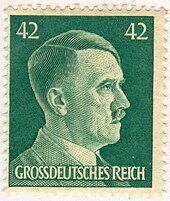Postage stamps and postal history of Germany
This is a survey of the postage stamps and postal history of Germany and philatelically related areas.
The Metzger Post was established in the twelfth century and survived until 1637, when Thurn und Taxis's monopoly took over.
[1] In 1497, on behalf of Emperor Maximilian I of the Holy Roman Empire, Franz von Taxis established a postal service that replaced the ad hoc courier for official mail.
[2][3] A horse relay system was created that shortened the transit time for mail and made its arrival predictable.
Thereafter, the house of Thurn und Taxis using the imperial yellow and black livery maintained the postal privilege for many centuries.
[4] Thurn und Taxis lost its monopoly when Napoleon granted the Rhine Confederation the right to conduct postal services.
but when Prussia created the North German Confederation, Thurn und Taxis had to sell its privileges in 1867.
States or entities that issued stamps subsequently were Baden (1851), Bergedorf (1861), Brunswick (1852), Bremen (1855), Hamburg (1859), Hanover (1850), Heligoland (1867), Lübeck (1859), Mecklenburg-Schwerin (1856), Mecklenburg-Strelitz (1864), Oldenburg (1852), Prussia (1850), Saxony (1850), Schleswig-Holstein (1850), and Württemberg (1851).
After the unification, Bavaria and Württemberg retained their postal authority to continue producing stamps until March 31, 1920.
[7] Heinrich von Stephan, inventor of the postcard and founder of the Universal Postal Union, was the first Postmaster-General.
Germania stamps were issued from 1900 until 1922 making it the longest running series in German philately with the change in the inscription from Reichspost to Deutsches Reich being the major modification during this period.
[10] During World War I, German authorities issued stamps in occupied countries, namely Belgium, Poland, Romania, and areas of the western and eastern front.
These areas briefly issued stamps: Allenstein and Marienwerder, Schleswig, and Upper Silesia.
After the 1939 occupation of Czechoslovakia, Czechoslovak stamps were initially overprinted before new designs were issued by Bohemia and Moravia.
During the course of World War II German authorities issued stamps in Albania, Alsace, Belgium, Channel Islands, Estland, parts of France, Kotor, Kurland, Latvia, Lithuania, Luxembourg, Macedonia, Montenegro, Poland (General Government), parts of Russia, Serbia, Slovenia, Ukraine, Zante, and Zara.
After World War II, the Saar territory came under French administration and issued its own stamps from 1947 to 1956.
[16] West Berlin, under the jurisdiction of the three western powers, started to release its own stamps on September 3, 1948.
About 3,000 different stamps were produced during the life of the existence of the DP; relatively low, however, was the number of semipostals.
With German reunification, the Bundespost with the incorporated Deutsche Post of the GDR provided postal services for the whole territory of the Federal Republic, and German stamps regardless of origin were postally valid until their date of expiration: for the stamps of the GDR Mi # 1004–3343, this was October 1, 1990, and for GDR Mi 3344-3365 December 12, 1991;[27] the latter was the same date for the expiration of the West Berlin stamps Mi #326–879.









